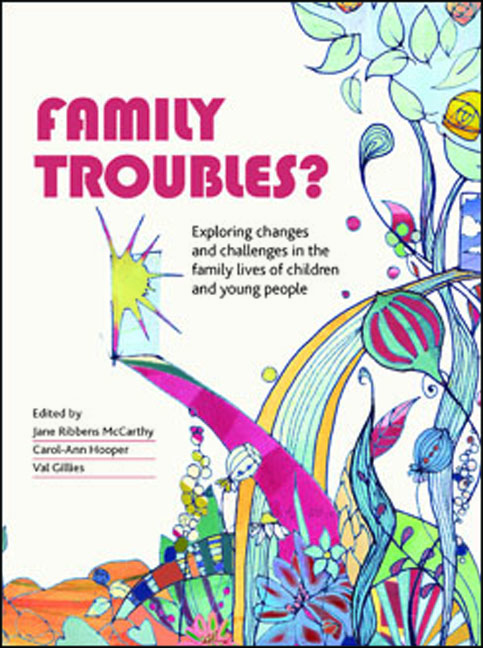Book contents
- Frontmatter
- Contents
- Notes on contributors
- Foreword
- Preface
- 1 Troubling normalities and normal family troubles: diversities, experiences and tensions
- Part One Approaching family troubles ? Contexts and methodologies :Introduction to Part One
- Part Two Whose trouble ? Conteste d definitions and practice: Introduction to Part Two
- Part Three The Normal, The Troubling And The Harmful?: Introduction to Part Three
- Part Four Troubles and transitions across space and culture: Introduction to Part Four
- Part Five Working With Families: Introduction to Part Five
- Index
25 - Working with fathers: risk or resource?
Published online by Cambridge University Press: 07 September 2022
- Frontmatter
- Contents
- Notes on contributors
- Foreword
- Preface
- 1 Troubling normalities and normal family troubles: diversities, experiences and tensions
- Part One Approaching family troubles ? Contexts and methodologies :Introduction to Part One
- Part Two Whose trouble ? Conteste d definitions and practice: Introduction to Part Two
- Part Three The Normal, The Troubling And The Harmful?: Introduction to Part Three
- Part Four Troubles and transitions across space and culture: Introduction to Part Four
- Part Five Working With Families: Introduction to Part Five
- Index
Summary
Policies in relation to child support, contact post-divorce and separation, and the reconciliation of paid work and care responsibilities have emerged in many countries over the last decades, with particular implications for men as fathers. This chapter, however, is concerned with developments that seem a particular feature of Anglophone countries such as the US and the UK from the 1990s onwards (Featherstone, 2009), which have called upon practitioners in a variety of welfare and education services to engage fathers and promote their involvement with children. This project has incorporated social investment and moral underclass discourses and highlighted the role of parents and parenting in promoting better outcomes for children (primarily those seen as disadvantaged).
It will be argued that such policy calls have failed to address tensions around the status of fatherhood and changes in family forms and gender relationships, despite preceding decades witnessing a considerable transformation in these. Moreover, the construction is of fathers as resources, with the risks that might be posed by violent or abusive practices left unaddressed. Thus, a normalising project has been pursued that ignores troubling questions about fathering status or their practices in relation to care. In order to accomplish normalisation, use has been made of a very narrow physiologically informed literature, with a neglect of wider sociological interrogations of fathering practices or gender inequalities (see, eg, Doucet, 2006; Dermott, 2008). In contrast, in areas of welfare work such as those concerned with the protection of children, policies have invoked a gender-neutral language of parenting, while practices have appeared to ignore fathers or construct them as risks. Thus, while some men as fathers have been actively invited into families, others have disappeared or been asked to.
However, the risk–resource dichotomy has been troubled to some extent in the child protection arena recently, and this chapter will highlight developments over the last decade that have emerged around working with men, fathering practices and domestic violence. Historically, work with men in relation to domestic violence has operated on the basis of all men as risks and has been promoted by constituencies with strong links to women's organisations and the refuge movement.
- Type
- Chapter
- Information
- Family Troubles?Exploring Changes and Challenges in the Family Lives of Children and Young People, pp. 315 - 326Publisher: Bristol University PressPrint publication year: 2013

